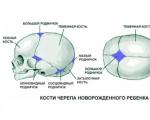How to teach a child to eat normally. Healthy food for children
It is no secret that parents sometimes themselves do not fully understand what proper and healthy baby food means. The good news is that after reading this article you will receive as many as 10 simple and understandable tips.
- Parental control. Who goes to the store and buys groceries? You yourself? Then you can place all the blame for your children’s poor nutrition on yourself. No child will go hungry. Children will eat everything they find in the cabinets and refrigerator. So if you don’t have enough healthy food in your kitchen, then you need to reconsider your standard shopping list.
- Let your child choose. On the one hand, it may seem too unusual and even wrong to ask a child about what and how much he wants. But if you stick to a daily routine with fixed times for breakfast, lunch, dinner and snacks, and cook tasty and varied meals, then the child will choose from what is available. It’s not at all difficult to have a pack or two of whole grain pasta and, say, rice in the kitchen. Offer to choose a side dish from these two options, and it will be healthy either way.
- Don't force you to finish eating. Let your child decide for himself whether he is full or not. This is the only way a person can learn to understand himself and avoid overeating.
- Start instilling healthy eating habits in your child from birth. Food addictions are formed at an early age, literally from the moment. Therefore, do not insist on some “so healthy cauliflower” if you do not want your child to be unable to look at it for the rest of his life. If your baby doesn't want to today, don't force feed. Introduce it after a week or two and maybe your child will try it.
- Diversify the children's menu. In fact, children love not only cookies and pasta with sausages. Offer them something completely new at home or let them choose for themselves in a cafe. You will be surprised how much children love to experiment.
- Count liquid calories. Carbonated sugary drinks contain a colossal amount of calories that provide no nutritional value. Gradually replace soda with water, milk, etc. This way you will not only satisfy your child’s thirst, but also provide him with the necessary vitamins and minerals.
- Don't overestimate dessert. If every meal ends with “an amazing, delicious dessert that I spent half the day making,” then the child begins to perceive the third course as something special. And you begin to want this incredible thing more and more, but ordinary food, especially vegetables, less and less. Do not focus on any food, and then the child will not beg for sweets with or without reason.
- Don't try to express your love for your child through food. It’s much better to just say once again how much you love him. If you use food (for example, some special dishes) as encouragement or a reason to delight your child, then most likely with age he will form the habit of eating stress and celebrating any events with feasts.
- Lead by example. Children, especially small ones, repeat everything after adults. It is difficult to teach your child to eat broccoli and brown rice if you yourself prefer pies and sandwiches. Change the diet of the whole family, gradually replacing unhealthy or unhealthy foods with tasty and nutritious ones. Use kitchen appliances such as a slow cooker, air fryer, or steamer. They allow you to cook food without adding or with a minimum amount of oil; very few vitamins are lost during processing, and the dishes turn out very tasty. If the whole family eats healthy and tasty food, then the child will too.
- Limit the time spent watching TV and computer. Using this method, you will be able to reduce the number and volume of snacks, which are also often not always healthy. And it’s better not just to forbid your child to watch cartoons, but to go for a walk with him or play outdoor games. Children love it much more.
Child's drinking regime
There are many opinions and recommendations about proper nutrition, but very little information about what children should drink and what not. A person drinks 1.5–2.5 liters of fluid per day, so it is very important to ensure that your child gets the maximum benefit from what he drinks.
How to get used to water and milk
Healthy food undoubtedly improves a child's mood and well-being.
For children of any age, the best way to quench their thirst is to drink a glass of plain water or milk. And not only because there are no calories in water, and there is a lot of calcium in milk, but because this way you can form the right habit of using milk and water, and not soda, to quench your thirst.
Here, for example, is the body’s need for calcium for children of different ages:
- Children from 1 year to 3 years – 700 mg of calcium daily (480 ml of milk).
- Children from 3 to 8 years old – 1000 mg (600 ml of milk).
- – 1300 mg (720 ml milk).
It's best to choose skim or low-fat milk to cut down on extra calories.
If your child doesn't like milk, try making a milkshake by adding some berries or fruits, such as strawberries or bananas. This smoothie is easy to make, tasty and sweet enough, and also contains additional vitamins and minerals.
If children drink a lot of soda, sports drinks, juices and juice drinks, then they not only take in huge amounts of sugar and empty calories, but they also begin to consume less milk and other dairy products (for example), depriving themselves of essential calcium. In addition, excess calories can lead to obesity and serious health problems (diabetes, hypertension).
Calorie and sugar content of various drinks
- Water (1 glass) – 0 calories and 0 g sugar.
- Low fat milk (1 cup) – 100 calories and 11 g of sugar.
- Freshly squeezed orange juice (1 glass) – 110 calories and 22 g of sugar.
- A juice drink containing 10% juice (1 glass) – 150 calories and 38 g of sugar.
- Carbonated sweet drink (1 glass) - 100 calories and 27 g of sugar.
Limit your juice intake
If your child loves juices, then make sure that only natural good juices are bought for him, and not juice drinks with a lot of sugar and flavoring additives.
Juice consumption rates for children of different ages:
- Up to 6 months – juice is not administered. The baby's main and only food should be breast milk or formula, as well.
- 6–12 months – no more than 120 ml of juice, can be diluted with water.
- 1–6 years – up to 200 ml per day.
- 7–18 years old – up to 350 ml per day.
Limit the amount of carbonated drinks
A variety of lemonades and colas are often bought for children. But parents do not always remember that soda contains large amounts of sugar and acid, which can lead to tooth decay and obesity. Moreover, such drinks often contain caffeine, and children definitely do not need to consume it. It is believed that the earlier a child tried soda, the more difficult it is to wean him off it and the more he will drink it in the future.
It is worth noting that there is no need to categorically prohibit your child from drinking lemonade. If this is a child under 7 years old, then just try not to let him try it, but if this is an older child, then explain why you don’t like soda, why it’s harmful and offer a tasty choice: iced tea with honey and lemon, a milkshake or homemade compote.
More about the culture of children's nutrition in the program "School of Doctor Komarovsky":
Preferences in food appear in the baby very early, already during the introduction of complementary foods. It depends on the parents whether the child will enjoy eating and how varied his taste range will be. Only thanks to adults can children learn that tasty is not only sweet.
That is why nutritionists advise starting complementary feeding with vegetables. It is likely that after trying sweet fruit purees, the baby will refuse carrots and zucchini. So, it’s easier to offer fruit and berry purees after mastering 5-6 types of vegetable ones. If a child refuses a vegetable, try giving it again in a few days; perhaps the negative attitude will pass by this time.
It must be remembered that each person requires a different amount of food. Also, the need for food depends on the intensity of growth, depending on the genetics of the person. Appetite is also associated with seasonal changes. In winter, children grow slower than in summer, and therefore eat less. And, of course, the more energy the baby spends, the more he eats. If a healthy child has a poor appetite, it is worth increasing his physical activity and spending more time in the fresh air.
Give your little eater the right to choose. Ask your child what he wants to eat from the full range of products offered. If possible, discuss in advance what dishes the child wants to see on the table. Children usually eat when they feel hungry and unconsciously choose foods that the body needs.
There is no need to worry about periodic refusals to eat if the child is gaining weight well. Having had a bad lunch, he will make up for everything during dinner. It is also worth excluding frequent snacks during the day, they suppress the feeling of hunger, but do not provide full energy to the body.
There is no need to force feed your baby - this can reinforce a negative attitude towards eating. Poor parental table behavior can lead to psychological barriers around food. It's better to let your child leave the table than to make dinner a torture for everyone.
Taste sensations are regulated by the brain. That is, over time, the child develops negative or positive feelings about various products. If at the time of tasting a new product the baby did not feel well, then a negative attitude towards it may remain for a long time. Therefore, it is recommended to introduce new products if the baby is healthy and in a good mood.
The environment in the kitchen is also important for a child. He should have his own dining place, bright and cheerful dishes. The food itself should also be beautiful, and not just healthy. You should not feed your baby in front of the TV, as this distracts from the eating process itself. Be an example for your child - behave calmly and politely at the table, eat with pleasure. All this will increase the child's chances of having an excellent appetite.
source http://www.detskydoctor.ru/
Very often mothers ask me the following question: “the child does not eat solid food, does not know how to chew, or is choking.” The problem is VERY common and, by the way, it appeared only recently, when the timing of introducing complementary foods was revised. Previously, the child received the first drying BEFORE the appearance of the FIRST teeth, and learned to chew with his gums. Now at 6 -6.5 months, most children have 2-4 front teeth, which are simply impossible to chew, but, importantly, they interfere with chewing with their gums. If you are against letting your child chew on a bagel or pieces of fruit (apple, pear) from 6-7 months, then there is only one way out - wait for a full set of molars to appear, and teach him to chew with them. From about one year of age, the child can gradually begin to eat solid food and chew small pieces.
So how can you teach a one-and-a-half-year-old or even worse, a 2-year-old baby to chew? The methods are quite simple, but require unanimity in execution, endurance and a little acting ability from parents and other relatives. But the point is simple: put the child in conditions where he simply cannot avoid chewing. Put yourself in the child’s shoes, why chew if you whine, and they will always give you something that you don’t need to chew.
The first thing is to practice chewing skills and the movements themselves. Here you will need marshmallows or chewing marmalade. At 1-2 years old, a child is already a decent thinker, so when he sees it in your mouth, he will probably ask for it too. And you: “I’ll give it to you, but you have to chew it, like this”... Naturally, the product must be of high quality.
The second is to “break” or lose the wiper (mixer, blender, strainer or masher), show the child the result and sincerely grieve with him, forgetting to promise if necessary (“when they appear in the store”) to buy another one. A promise to try not to keep. You can offer the child, “since he is already big,” to chop his own food on his plate, using a fork, for example. It turns out to be a kind of competition between two laziness: “too lazy to chew” and “too lazy to crush.” As a rule, sooner or later the last one wins.
Third, stop cooking pureed dishes whenever possible. If he refuses to eat something else, don’t feed him. Just leave snacks in accessible places. Do not be afraid that the lack of regular three-course and multi-course meals will ruin your child’s stomach. Decisive measures will help teach you to chew quite quickly, but “cutting off the tail in parts” will do the opposite. Therefore, the result depends solely on your perseverance and inflexibility. And it’s quite possible to last a year or two on such a diet without any damage to your health, it’s been tested!
Fourth, very often children begin to chew a new, previously unfamiliar dish. Think about how you can expand your diet. Naturally, the new product should be offered ONLY in a non-pureed or crushed form.
Fifth, go out into public more often. Eating outside the home, as a rule, does not imply special preparation of food according to the whims of the child. Snacking on the go in the park, picnics in nature, going to affordable catering establishments (like McDonald's), especially when surrounded by other children, usually have a positive effect. Only the principle should be the same: eat what you have, there is no other food here.
And, in my opinion, the most important rule - with all this - is no talking, conversations, worries, nightly thoughts and complaints to others about the child’s non-chewing. Let him think that everything is OK with him. 1-2 years is a very dangerous age in terms of the beginning of manipulation of parental feelings. It's not a good idea if your baby uses his chewing/non-chewing to blackmail you.
and from me personally - the custom of giving chewed bread to children is the main cause of child mortality from intestinal infections. Don't chew, please! and I wish you to cope with your problem))))
In the first months of life, the baby receives breast milk (or its substitutes), and with it all the necessary nutrients. During this period, children express the so-called innate (unconditioned) reflexes, primarily the sucking, as well as the protective “pushing” reflex: when solid or large particles of food enter the baby’s mouth, child automatically pushes out foreign objects with the tongue to avoid choking. In addition, the gag reflex is quite developed (it is caused by irritation of the back or root of the tongue, for example, with a spoon). Aged from 4 to 6 months these reflexes weaken, which is the reason for introducing complementary foods into the children's diet and starting gradual transition from liquid food to solid food, from the sucking process to the chewing process. Now it becomes clear why attempts by parents to start feeding their child with a spoon early (up to 3-4 months) cause “protests”, the baby pushes out the spoon, spits out food, and sometimes vomiting may occur. So, after 4-6 months, the toddler is able to eat pureed food from a spoon, but food containing even small lumps is recommended to be introduced into the children's diet during the period of active teething (usually from 6-7 months and not earlier). This is the time that is considered the most favorable for accustoming baby to more solid food - the baby reflexively pulls hard objects into the mouth in order to “scratch” the gums. A permissive “signal” for the transition from puree to food with lumps can also be changes in the baby’s behavior - if he begins to take an active interest in the food on his plate and yours, “begs” for your food, puts it in his mouth and bites a spoon, opens his mouth wide when when feeding, does not suck food from a spoon, but removes it with his upper lip and tries to chew. The principle of matching the size of food pieces to age categories is strictly observed in the industrial production of canned food for baby food. So vegetable purees They are divided according to the degree of grinding to homogenized(for children from 4-4.5 months) and mashed (for children over 6 months). Meat purees are divided into homogenized (particle size up to 0.3 mm; intended for children from 6-7 months), puree (particle size up to 1.5 mm; suitable for children from 7-8 months), coarsely ground (particle size up to 3 mm; intended for children from 9-12 months). Grinding degree fish and vegetable purees: pureed (particle size up to 2.5 mm; for children over 8-9 months) and coarsely ground (particle size up to 4 mm); for children from 11-12 months. The baby will be able to eat solid food and pieces of food (for example, meat or fish) when he has a sufficient number of teeth, usually in 12 months and older. The final eruption of primary teeth occurs by the age of 2 years.| To prepare children's meals at home, try to adhere to the following recommendations. For getting homogenized puree, Boiled vegetables and meat are passed through a meat grinder twice, then after adding vegetable broth or milk, they are beaten in a blender. After which a homogeneous mass is obtained. Puree vegetables prepared by boiling and then grating on a fine grater or passing through a meat grinder once, then add vegetable broth and mix until puree is obtained. For getting puree with chunks(up to 1.5 mm), it is enough to pass the meat through the meat grinder once, but then mix it with a blender, and to obtain larger particles, it is enough to stir the meat rolled in the meat grinder with a fork or whisk. Coarse puree can be obtained by separating meat or fish into fibers (split by hand or crush with a spoon, and then finely chop across the fibers. Then add vegetable broth or boiled milk (mixture), and to obtain meat-fish-vegetable puree, add pureed vegetables and stir over a small mixer speed. |



